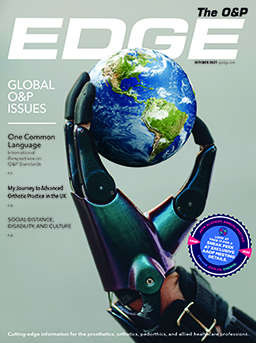Five Questions for Don Buethorn, CPO
 |
Don Buethorn, CPO, is the owner of Cascade Prosthetics & Orthotics and Cascade DAFO, Bellingham, Washington. More than 25 years ago, the multitalented clinician, entrepreneur, and designer met physical therapist Nancy Hylton, PT, who requested that he build for her a series of short, relatively flexible, wrap-around pediatric MSO braces. Within a few years, Buethorn was filling orders from around the country for these braces, the Dynamic AFOs, and perfecting the designs. The business mushroomed, and today Cascade DAFO produces about 450 braces per day. Buethorn credits much of his success to the team at Cascade, which includes "extremely talented, hardworking, detail-oriented" workers. The Cascade team's passion, Buethorn maintains, allows the business to thrive and gives him the support he needs to maintain not only the business but also his busy clinical practice and a very involved family life with his wife, three children, and pets.
1. How did you become involved in O&P?
After getting my first degree in special education and general biology, I went into the Marine Corps, with my goal being to get a master's degree in physical therapy when I got out. When I arrived for my interview with the department of physical therapy at the University of Washington (UW), no one was there to see me. While I was there, a man struck up a conversation with me. He said that I should be a prosthetist or an orthotist, that he was head of that school at UW, and he wanted me to be in his program. I applied there, and that's how I went at. It was quite a blessing for me because it was a perfect match.
2. What has motivated you in your professional pursuits?
I love the challenge of pushing the art and trying to make things work for each patient. A lot of our developed braces come from my clinical experience. If I find a solution for a person who has a particularly challenging issue, I try to share that with other practitioners. It gives me a blend of clinical work—which I really, really like—and product development.
3. How has your career progressed?
A few years into my first practice, I found myself becoming bored. Not that it wasn't challenging—it's very hard to consistently produce devices that are comfortable and work—but it was becoming repetitive. That was when I met Nancy Hylton, who's a master, maybe a genius. She had the idea for the DAFOs. It was so refreshing because it was entirely new. I didn't have the time or any technicians to help me do what she was asking, but I agreed to do it anyway because it was interesting. I started making the braces for her and saw that the design worked extraordinarily well. The word moved along the therapist grapevine, and pretty soon, I had more business than I could possibly deal with.
4. What is your approach to patient care?
Listen, listen, listen. Nearly everybody will tell you in some way what they need and want. The more you can say yes to whatever they're asking for and try to see what they want, not prejudging what should or shouldn't be done, the better off you'll be. It means that all your techniques have to be constantly examined. You have to be willing to try new things, knowing that you're going to make some mistakes and have to redo them.
5. What emerging trends do your see for your field?
Some practitioners are still wedded to the idea of being fabricators, but I think that's becoming rarer and rarer. I think when practitioners start seeing themselves as providers of knowledge and managers of processes, and not being didactic about things being done a certain way, we can provide the patient the most appropriate answers.






-
-
-
-
CONTACT US